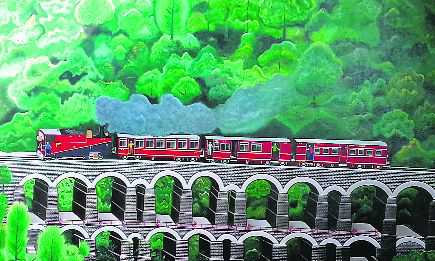Shriniwas Joshi
The Kalka Shimla Railway (KSR) is in news these days. It has successfully completed a trial trip with see-through Vistadome coach having a seating capacity of 36 recently.
Vistadome, called Nihaar in Hindi, has modified windows and conditioned system. It is fitted with designer LED lights and is fully air-conditioned. Passengers can now sit relaxed on their seats and enjoy the beautiful natural view while covering the distance between Shimla and Kalka in five hours. The timing, fare and the number of coaches attached to the train are to yet to be decided.
Most people believe that Himachal has two UNESCO World Heritage Sites — Kalka-Shimla Railway (declared a World Heritage Site in 2008) and the Great National Himalayan Park in Kullu (so certified in 2014). Actually, KSR is not a world heritage site on its own, but finds place as one of the Mountain Railways of India, to which the other two railways — Darjeeling Himalayan Railway and Nilgiri Mountain Railway, declared so in 1999 and 2005, respectively, had already made their marks.
KSR is a World Heritage Site, which Himachal shares with West Bengal and Tamil Nadu. Our neighbouring states Punjab, Haryana and J&K are yet to make entry into the coveted list, whereas Uttarakhand has tick-marked the list with Nanda Devi and Valley of Flowers National Park (included in 1939 and 1982). Chandigarh has UNESCO World Heritage Site in the architectural works of Le Corbusier.
KSR is one of the most surveyed lines. The Delhi Gazette of 1847 with a proposed sketch route of KSR reads: "We might then see these cooler regions become the permanent seat of a government daily invigorated by a temperature adapted to refresh a European constitution and keep the mental powers in a state of health alike, beneficial both to the rulers and the ruled."
The extension of Ambala-Kalka strip of East Indian Railways in 1865 initiated various surveys for KSR — of 1884, 1885; project report of 1887 and another survey of 1895. A contract, nevertheless, was signed between the secretary of the state and Delhi-Ambala-Kalka Railway Company on June 29, 1898, for the construction of a 2-feet line with no government grant, but provision of land in gratis. Military authorities put pressure on the government to agree to two-and-a-half feet line. A fresh contract signed on November 15, 1901, resulted in re-doing the already laid portion of the line. Lord Curzon inaugurated this 59.44-mile long track, constructed under the supervision of chief engineer HS Harrington on November 9, 1903, the date on which the first train pulled by a locomotive built by British firm Sharp Stewart arrived in Shimla. I would be missing the bus if I don’t mention the name of 'illiterate genius of Bhalku from Chail' without whose help Harrington could not have brought the train to Shimla. Bhalku would point out to the authorities the spaces, where to dig a tunnel or make a bridge or lay the railway track on through a long staff he always carried with him. And the British believed in his supernatural powers. He had, on his head, matted hair full of lice fed on flour and sugar poured by him on his head because he believed that his deity conversed with him through these fleas.
The company, despite the jacked up fare, suffered financial losses and sent an SOS to the government that purchased KSR on January 1, 1906. Besides Barog, the longest tunnel (3,752 feet) named after the engineer who tried to construct it and committed suicide for laying wrong alignment, KSR now passes through 102 tunnels (not 103, because tunnel number 46 does not exist), which means that KSR crawls from tunnel 45 to 47. KSR passes over 869 bridges representing about 3 per cent of the line, a couple of bridges are three or five-stage 'arch-galleries' that resemble ancient Roman aqueducts. I saw a painting, at Kalka Railway Station, of KSR passing through one such aqueduct. The other display board was there to declare KSR as a world heritage site. But surprisingly, none from Himachal was present on the D-day (Nov 9, 2008), whereas the entire route of the train is through Himachal.
Tailpiece
Two drunks were stumbling home along a pair of railway tracks. The first drunk complains: "There's a hell of a lot of steps here." The second drunk replies: "I'll tell you what's worse, the hand railings are bloody low down."
Its claim to fame
Robert Lee and Ian Walker of UNESCO inspected the track and visited several railway stations in September 2007. They were impressed by its age-old communication system, the use of ancient block phones and functional 'stop and go signal lanterns' of the British period, hence recommended its inclusion among the 'world heritage sites'.
Unlock Exclusive Insights with The Tribune Premium
Take your experience further with Premium access.
Thought-provoking Opinions, Expert Analysis, In-depth Insights and other Member Only Benefits
Already a Member? Sign In Now










